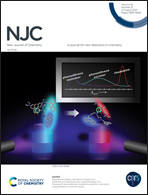Pillar[6]arene-modified gold nanoparticles grafted on cellulose nanocrystals for the electrochemical detection of bisphenol A†
Abstract
In this study, a macrocyclic cationic pillar[6]arene (CP6)-modified gold nanoparticle (CP6-AuNP)-functionalized cellulose nanocrystal (CNC) nanohybrid is prepared. The obtained CNC@CP6-AuNP nanohybrid exhibits high electrocatalytic activity and excellent selective molecular recognition capability towards the electrochemical determination of bisphenol A (BPA). The electrode, operated at a working potential of 0.3 to 0.9 V, works in the concentration range of 0.05–100 and 100–500 μM BPA and has a 12 nM detection limit. The host–guest interactions are studied via fluorescence titration experiments, indicating more affinity and a high binding constant (Ka) of 4.29 × 104 M−1 by electrostatic interactions and hydrophobic interactions between CP6 and BPA. The electrochemical sensing has also been used to detect BPA in tap water and milk samples with satisfactory results. Finally, this study can provide a novel method for the design of a macrocycle host-modified metal nanoparticle-functionalized hybrid material for catalysis, sensing, materials science and other fields.
![Graphical abstract: Pillar[6]arene-modified gold nanoparticles grafted on cellulose nanocrystals for the electrochemical detection of bisphenol A](/en/Image/Get?imageInfo.ImageType=GA&imageInfo.ImageIdentifier.ManuscriptID=D1NJ02040D&imageInfo.ImageIdentifier.Year=2021)


 Please wait while we load your content...
Please wait while we load your content...